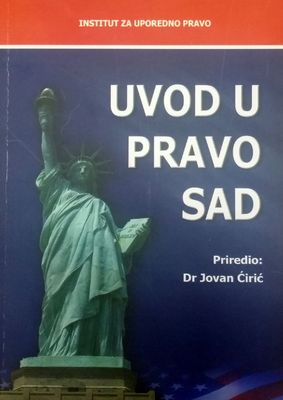Vrhovni sud SAD – organizacija, funkcije, rana istorija
The United States Supreme Court – Organization, Functions, Early History
Author(s): Predrag Vukasović
Subject(s): History of Law, Constitutional Law
Published by: Institut za uporedno pravo
Keywords: Supreme court; organization; functions; history; USA Constitution
Summary/Abstract: The United States’ Supreme Court (USSC) is the highest body of judiciary in USA. Its powerful position reflects the entire status of government’s judicial branch in American political system, marked by a complex play of independence and interdependence. It is often said that judiciary is more equal than other two branches - executive and legislature. American social, economic, even political history is able to be written in terms of Supreme Court’s decisions, as well as through the usually applied succession of the presidential administrations. The present contribution ought to examine the Supreme Court’s role in the working of USA Constitution. The main stress is laid upon its function as a kind of Constitutional Tribunal of the continental legal systems. The key organizational guarantees of its independence, as well as the inherent limits of their effectuality are reviewed. Its members are appointed by President with Senate’s approval. The independence from executive and legislative branches is due to their unlimited term of office, the clear-cut sphere of its jurisdiction and the precedent nature of American legal system, inherited from English common law. The US Supreme Court can be defined as specific combination of an appeal, cassation and
constitutional tribunal. Besides, it has some very restricted original competences.
But the Court’s politically most important power is to declare every executive or
legislative act null and void unless its provisions are consistent with USA Constitution. For this reason, every President endeavored to have its makeup favorable to his own policies, using his right to appoint its members for creating a majority prone, capable and ready to support him. The executive’s influence on Supreme Court is reflected into divisions and disagreements among its own members, aligned with the conservative, mainstream and liberal wings of political spectrum. These differences have ever existed in the highest American tribunal, but they are increasingly sharpened from Reagan’s conservative revolution onwards. The particular attention is paid to the formative period of Supreme Court’s history. Few seminal decisions are cited in order to illustrate the means by which Supreme Court was, through the interpretation of constitutional provisions, shaping the entire political and legal system of newly-founded Republic.
Book: Uvod u pravo SAD
- Page Range: 105-139
- Page Count: 35
- Publication Year: 2008
- Language: Serbian
- Content File-PDF

